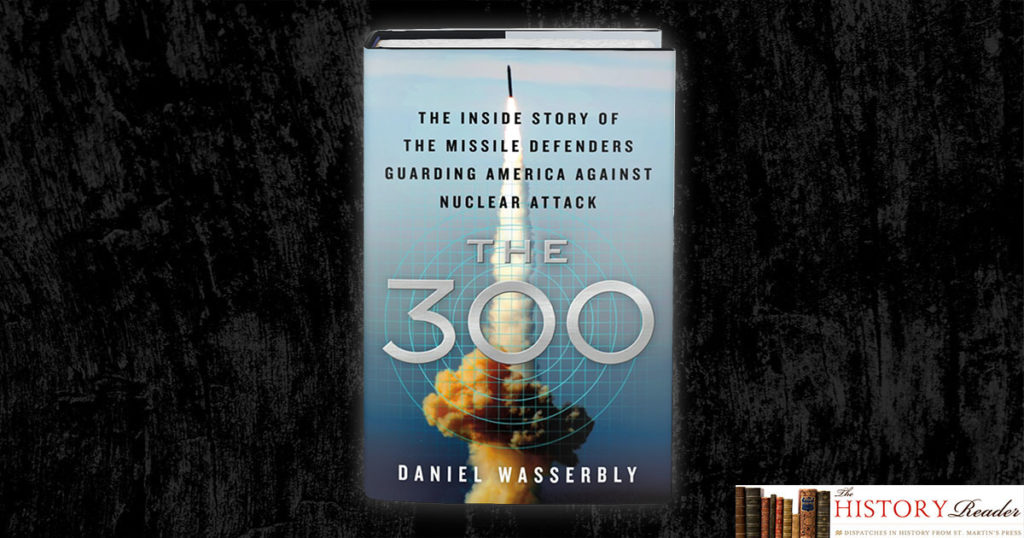By Daniel Wasserbly
In The 300, military and security expert Daniel Wasserbly introduces the elite unit tasked with protecting the nation from long-range weapons of mass destruction. Read on for an excerpt.

This work created by the United Kingdom Government is in the public domain.
On September 8, 1944, the missile age began. A German V-2 guided ballistic missile was launched from Nazi-occupied Holland and about five minutes later, at 6:43 p.m., exploded in west London’s Chiswick district. It left a thirty-two-foot crater on Staveley Road, killed three people, and injured twenty-two more. Chiswick’s terrified residents thought they’d heard a second explosion, but the single missile moved faster than the speed of sound, so its approach wasn’t heard until after it blew up on the street. More than a thousand V-2s were launched at the United Kingdom in the coming year, hundreds specifically targeting London, and hundreds more targeting cities in Belgium and France. Thousands died.
Ideas for defending against these Vergeltungswaffen, or “vengeance weapons,” began emerging shortly after evidence of the first developmental V-2s was brought to British military officials in July 1944. In response, the British evolved radar teams to spot incoming missiles and were able to approximate where the weapon might strike. General Frederick Alfred Pile, commander of the British Army’s Anti-Aircraft Command, argued the radar data could be used to direct antiaircraft guns to shoot missiles down with a massive barrage of exploding artillery shells. It was quickly determined, though, that firing a shield of aerial shrapnel over London was unfeasible, and would potentially kill more civilians than it would save. In this case, the Allied powers believed the best defense was a good offense, and they focused instead on bombing V-2 production or launch facilities.
Pile pressed on for a defensive solution. He developed a scheme to divide London into defended grid squares, and to use better radar data to more precisely target incoming missiles. But the general never got to test his idea. “Monty beat us to it,” he wrote. Field Marshal Bernard Montgomery had liberated German-controlled missile launching areas in Holland, and the attacks ceased.
After the war, US military officials began to worry about missile threats, prompted by concern that Germany had been developing ICBMs to negate the United States’ natural geographic advantage, and so might others, namely the Soviet Union. Washington was now working with Wernher von Braun, a German aerospace engineer who had developed the V-2 for Adolf Hitler, but Moscow controlled the original V-2 factory and test facilities. The United States and Soviet Union were in a desperate competition to harness the deadly technology and significantly boost its range. With this in mind, a number of US government studies in the late 1940s began exploring the feasibility of antiballistic missile defenses. These early efforts made little headway, with the army simply offering to modify its Nike air defense system that was designed to shoot down enemy bombers.

This file is in the public domain in the United States because it was solely created by NASA.
In 1955, the United States began to fear the Soviets might indeed soon field long-range ballistic missiles, so the Pentagon contracted Bell Telephone Laboratories to identify potential solutions. Bell reported that destroying a ballistic missile was possible, but powerful long-range radar needed to be developed for the job. That wasn’t all. The military would also need communication networks, radars woven together to detect and track incoming missiles, data processing centers, more powerful computers, and advanced command-and-control systems. All this new technology would have to work together quickly and flawlessly. At the business end would be an interceptor missile, known as Zeus. In early 1957 the army began work on what it called the Nike Zeus “antimissile missile system.” Nike Zeus seemed all the more meaningful when, in August 1957, the Soviet Union announced it had successfully tested its SS-16 ICBM. Two months later, the Soviets launched Sputnik, Earth’s first artificial satellite.
The army hoped to field Nike Zeus sometime in the early 1960s, but questions quickly arose about technical feasibility and high costs. The system’s basic concept was captured well by the Atari Missile Command video game: the player identifies an incoming nuclear warhead and then launches his own nuclear-armed missile to detonate as close as possible to it, thereby destroying the ascending warhead (but hopefully not destroying his own radar, communications, and command-and- control systems).
Among other criticisms, a group of Pentagon engineers in mid-1958 reported that Nike Zeus could possibly work against one incoming warhead, but it would be overwhelmed and defeated if the Soviets developed a missile that carried multiple warheads. It could also be overwhelmed by decoys such as metal chaff and Mylar balloons, or simply rendered useless if its radar sites were destroyed first. The army ran a series of relatively successful simulated intercepts, with Nike Zeus interceptors flying close enough to the enemy warhead to theoretically destroy it by detonating its own nuclear device, but no live fire tests were done. The project had opponents in John F. Kennedy’s White House and Pentagon, in Congress, and in the rival air force. It was relegated to a testing and development phase until 1963.
The missile defense program then progressed into the Nike-X program. Nike-X increased the interceptor’s range from 250 to 450 nautical miles and renamed it Spartan, added a short-range interceptor known as Sprint, and introduced a far more advanced phased array radar. The army–air force rivalry had cooled as the ground service was officially assigned the new antiballistic missile role, or ABM. President Kennedy warmed to the idea of ballistic missile defense.
In 1963, the president was not yet willing to deploy it, however, and felt the system needed more development. Kennedy was surprised that scientists disagreed so strongly about the concept’s feasibility, which he assumed was a technical issue on which engineers should find consensus. But they did not agree, and quarrels in the scientific community regarding missile defense persisted for another six decades. Kennedy would not weigh in on the debate further—he was assassinated that November. His secretary of defense, however, would forever shape how the country discussed and viewed nuclear weapons and missile defenses.


Daniel Wasserbly is the editor of Jane’s International Defence Review, a global publisher of military and security news and open-source intelligence. He has appeared as a military expert for BBC World Service and NPR’s Marketplace, and has discussed missile defense and security issues on the Korean peninsula. He has appeared on CNN, CBC Television, BBC, CBC Radio One, and in The New York Times, The Wall Street Journal, Financial Times, and other publications.
